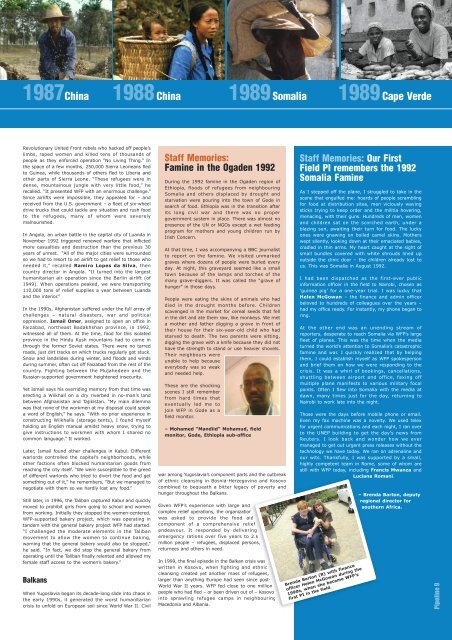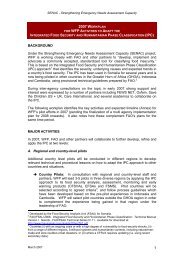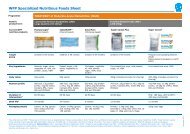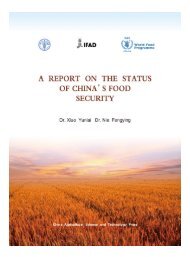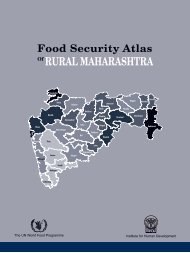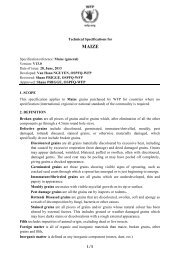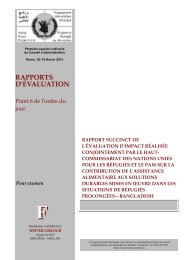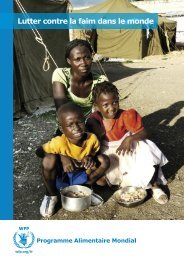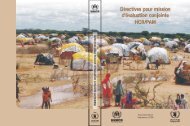Pipeline 50 Years - WFP Remote Access Secure Services
Pipeline 50 Years - WFP Remote Access Secure Services
Pipeline 50 Years - WFP Remote Access Secure Services
- No tags were found...
Create successful ePaper yourself
Turn your PDF publications into a flip-book with our unique Google optimized e-Paper software.
<strong>WFP</strong>/T. Page<strong>WFP</strong>/Paul Mitchell<strong>WFP</strong>/Jeff Share<strong>WFP</strong>/Mercedes Sayagues1988 1989 1989 1987China China SomaliaCape VerdeRevolutionary United Front rebels who hacked off people’slimbs, raped women and killed tens of thousands ofpeople as they enforced operation “No Living Thing.” Inthe space of a few months, 2<strong>50</strong>,000 Sierra Leoneans fledto Guinea, while thousands of others fled to Liberia andother parts of Sierra Leone. “These refugees were indense, mountainous jungle with very little food,” herecalled. “It presented <strong>WFP</strong> with an enormous challenge.”Since airlifts were impossible, they appealed for – andreceived from the U.S. government – a fleet of six-wheeldrive trucks that could tackle any situation and rush foodto the refugees, many of whom were severelymalnourished.In Angola, an urban battle in the capital city of Luanda inNovember 1992 triggered renewed warfare that inflictedmore casualties and destruction than the previous 30years of unrest. “All of the major cities were surroundedso we had to resort to an airlift to get relief to those whoneeded it,” recalled Ramiro Lopes da Silva, thencountry director in Angola. “It turned into the largesthumanitarian air operation since the Berlin airlift (of1949). When operations peaked, we were transporting110,000 tons of relief supplies a year between Luandaand the interior.”In the 1990s, Afghanistan suffered under the full array ofchallenges – natural disasters, war and politicaloppression. Ismail Omer, assigned to open an office inFaizabad, northeast Badakhshan province, in 1992,witnessed all of them. At the time, food for this isolatedprovince in the Hindu Kush mountains had to come inthrough the former Soviet states. There were no tarredroads, just dirt tracks on which trucks regularly got stuck.Snow and landslides during winter, and floods and windsduring summer, often cut off Faizabad from the rest of thecountry. Fighting between the Mujahedeen and theRussian-supported government heightened insecurity.Yet Ismail says his overriding memory from that time waserecting a Wiikhall on a dry riverbed in no-man’s landbetween Afghanistan and Tajikistan. “My main dilemmawas that none of the workmen at my disposal could speaka word of English,” he says. “With no prior experience inconstructing Wiikhalls (storage tents), I found myselfholding an English manual amidst heavy snow, trying togive instructions to workmen with whom I shared nocommon language.” It worked.Later, Ismail found other challenges in Kabul. Differentwarlords controlled the capital’s neighborhoods, whileother factions often blocked humanitarian goods fromreaching the city itself. “We were susceptible to the greedof different warlords who tried to divert the food and getsomething out of it,” he remembers, “But we managed tonegotiate with them so we hardly lost any food.”Still later, in 1996, the Taliban captured Kabul and quicklymoved to prohibit girls from going to school and womenfrom working. Initially they stopped the women-centered,<strong>WFP</strong>-supported bakery project, which was operating intandem with the general bakery project <strong>WFP</strong> had started.“I challenged the moderate elements in the Talibanmovement to allow the women to continue baking,warning that the general bakery would also be stopped,”he said. “In fact, we did stop the general bakery fromoperating until the Taliban finally relented and allowed myfemale staff access to the women’s bakery.”BalkansWhen Yugoslavia began its decade-long slide into chaos inthe early 1990s, it generated the worst humanitariancrisis to unfold on European soil since World War II. CivilStaff Memories:Famine in the Ogaden 1992During the 1992 famine in the Ogaden region ofEthiopia, floods of refugees from neighbouringSomalia and others displaced by drought andstarvation were pouring into the town of Gode insearch of food. Ethiopia was in the transition afterits long civil war and there was no propergovernment system in place. There was almost nopresence of the UN or NGOs except a wet feedingprogram for mothers and young children run byIrish Concern.At that time, I was accompanying a BBC journalistto report on the famine. We visited unmarkedgraves where dozens of people were buried everyday. At night, this graveyard seemed like a smalltown because of the lamps and torches of themany grave-diggers. It was called the “grave ofhunger” in those days.People were eating the skins of animals who haddied in the drought months before. Childrenscavenged in the market for cereal seeds that fellin the dirt and ate them raw, like monkeys. We meta mother and father digging a grave in front oftheir house for their six-year-old child who hadstarved to death. The two parents were sitting,digging the grave with a knife because they did nothave the strength to stand or use heavier shovels.Their neighbours wereunable to help becauseeverybody was so weakand needed help.These are the shockingscenes I still rememberfrom hard times thateventually led me tojoin <strong>WFP</strong> in Gode as afield monitor.– Mohamed “Mandiid” Mohamud, fieldmonitor, Gode, Ethiopia sub-officewar among Yugoslavia’s component parts and the outbreakof ethnic cleansing in Bosnia-Herzegovina and Kosovocombined to bequeath a bitter legacy of poverty andhunger throughout the Balkans.Given <strong>WFP</strong>’s experience with large andcomplex relief operations, the organizationwas asked to provide the food aidcomponent of a comprehensive reliefendeavour. It responded by deliveringemergency rations over five years to 2.6million people – refugees, displaced persons,returnees and others in need.In 1999, the final episode in the Balkan crisis waswritten in Kosovo, when fighting and ethniccleansing created yet another mass of refugees,larger than anything Europe had seen since post-World War II years. <strong>WFP</strong> fed close to one millionpeople who had fled – or been driven out of – Kosovointo sprawling refugee camps in neighbouringMacedonia and Albania.Staff Memories: Our FirstField PI remembers the 1992Somalia FamineAs I stepped off the plane, I struggled to take in thescene that engulfed me: hoards of people scramblingfor food at distribution sites, men viciously wavingsticks trying to keep order and the militia hovering,menacing, with their guns. Hundreds of men, womenand children sat on the scorched earth, under ablazing sun, awaiting their turn for food. The luckyones were gnawing on boiled camel skins. Motherswept silently, looking down at their emaciated babies,cradled in thin arms. My heart caught at the sight ofsmall bundles covered with white shrouds lined upoutside the clinic door – the children already lost tous. This was Somalia in August 1992.I had been dispatched as the first-ever publicinformation officer in the field to Nairobi, chosen as‘guinea pig’ for a one-year trial. I was lucky thatHelen McGowan – the finance and admin officerbeloved to hundreds of colleagues over the years –had my office ready. For instantly, my phone began toring.At the other end was an unending stream ofreporters, desperate to reach Somalia via <strong>WFP</strong>’s largefleet of planes. This was the time when the mediaturned the world’s attention to Somalia’s catastrophicfamine and war. I quickly realized that by helpingthem, I could establish myself as <strong>WFP</strong> spokespersonand brief them on how we were responding to thecrisis. It was a whirl of bookings, cancellations,shuttling between airport and office, faxing offmultiple plane manifests to various military focalpoints. Often I flew into Somalia with the media atdawn, many times just for the day, returning toNairobi to work late into the night.Those were the days before mobile phone or email.Even my fax machine was a novelty. We used telexfor urgent communications and each night, I ran overto the UNEP building to get the day’s news fromReuters. I look back and wonder how we evermanaged to get out urgent press releases without thetechnology we have today. We ran on adrenaline andour wits. Thankfully, I was supported by a small,highly competent team in Rome, some of whom arestill with <strong>WFP</strong> today, including Francis Mwanza andLuciana Romani.Brenda Barton (R) with financeofficer Helen McGowan during the1990s, when she became <strong>WFP</strong>’sfirst PI in the field.– Brenda Barton, deputyregional director forsouthern Africa.<strong>Pipeline</strong> 9


